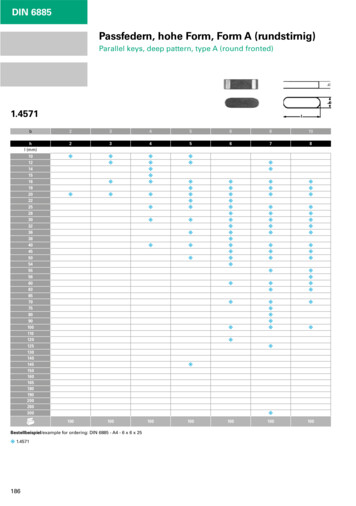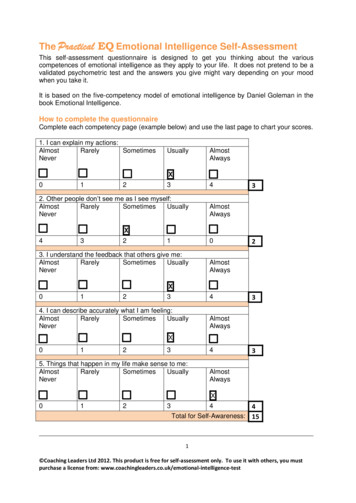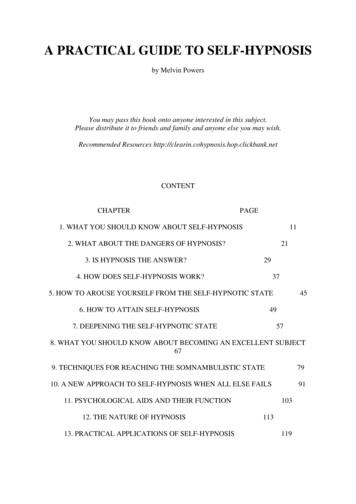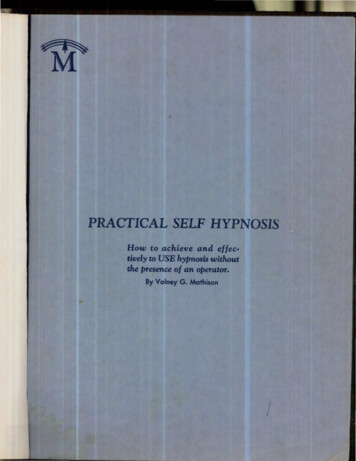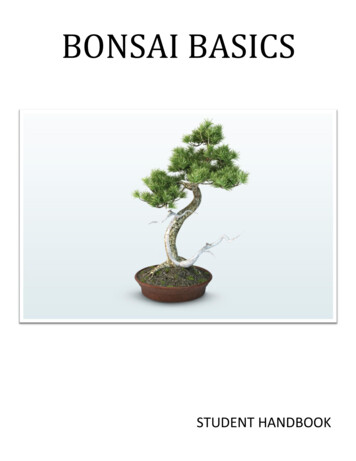
Transcription
Beginners ManualPractical Self-DefenseTraditional Form
Techniques {1 Stripe}Basics {1 Stripe}1: Inward DefenseStances:2: Outward Defense1: Attention3: Blocking the Sun2: Horse4: Sweeping Serpent [A/B]3: Crane5: Kimono Grab4: Bow [Neutral]6: Striking Asp [A/B/C]5: Twist7: The Dancer6: Cat [45/90]8: Cutting the Pagoda7: Kneel [close/wide]9: The Bridge10: Bear Hug [Free in Back]Blocks:1: Inward2: OutwardKata {1 Stripe}3: UpwardShort 14: Downward5: Extended OutwardNeed to know:Name all 7 StancesKicks:Name all 5 Animals1: Front SnapDefinition of Kenpo2: WheelDefinition of Karate3: Knife EdgeWhat does Salutation Represent4: Rear ThrustKenpo Creed5: Cross Over Side ThrustStrikes:Foot Maneuvers:1: Single Punch1: Jump Switch2: Double Punch2: Cross Over Step Out3: Half Fist3: Twist Stance [Advancing/Retreating]4: Asp Hand4: Cover5: Hand Sword Chop [Inside/Outside}
Northwest Kenpo Karate Protocol and Discipline“Karate-do”, The Empty Hand Way. The study and practice of the emptyhand way. Karate-do is practiced in and out of the dojo. It is a combination ofspiritual discipline, physical education and self-defense.The Karate student is always a student, no matter where he or she maybe. He or she must always observe proper etiquette. He or she must alwaysrespect and honor those who teach and instruct.Verbal Respect5th through 10th degree black belts shall be addressed as “Shihan”2nd through 4th degree black belts shall be addressed as “Sensei”Brown belts & 1st degree black belts shall be addressed as “Sempai”Personal HygieneWash your GI and workout clothes after every classShower before and after classBrush teeth and wear deodorant before classKeep finger and toe nails trimmedPractice good hygiene every day, in and out of the dojo!BowingBow upon entering the training area (the dojo) then bow to the instructorand any visiting black belts.Bow facing training area when leavingBow before and after work with partnerBowing is a way of showing respect for your partner and your dojoTraining Area (Dojo)The training area is for training not for playing – please come to train andlearnWear appropriate training clothingNo food or drink, except water in the training areaWhen coming in late, wait at edge of training area to be bowed in beforeyou enterWhen leaving early ask permission from instructor and bow outWhen adjusting uniform, clothing or belt do not face the instructor or otherguest black belts
AttitudeWe are all human with many strengths and weaknesses. Always show upwith a positive attitude. You get what you put in. Leave your anger and negativeattitude out of your training. Be ready to learn and help others learn.Train with a Positive AttitudeNegative thoughts produce negative resultsRespect the words and ways of the instructorsAvoid self-conceit and arroganceOne who brags will never earn true respectConceit and boasting brings dishonor upon the school and one’s selfTake your Training SeriouslyBe prepared at all timesYou must try hard at all timesPay attention and focusPractice as often as you canBePatientKind and yRespectfulForgivingBraveDo Not BeJealousA ngeful
Terms you should knowBlock: Defensive maneuver of force meeting forceBushido: Way of the warrior, pride in duty, discipline in conduct andhumility in one’s selfCheck: To restrain or hinder an opponent from taking actionDojo: The gym, the place where we train, Training HallGI: UniformKata: A set routine of strikes, blocks and kicks against imaginaryopponents, which teaches techniques, power, speed, agility andbreath controlKarate-do: Empty hand way or way of the empty hand(Kara Empty Te Hand Do way)Kenpo: Way of the fist or Fist lawKiai: Spirit yell used to scare your opponent, get air out of yourlungs and bring forth inner strengthMarriage of Gravity: Uniting strength, mind and breath whiledropping your body weightParry: Defensive maneuver of redirecting forceShihan: Master or Professor, black belt ranking 5th to 10th degreeSensei: Teacher or Instructor, black belt ranking 2nd to 4th degreeSempai: Senior student or assistant instructor, brown belt and 1stdegree black beltSpeed: Double the velocity, quadruple its impactTorque: Force produced by axis of rotation
Kenpo CreedI come to you with only Karate,Empty hands.I have no weapons, but should I beforced to defend myself, my principlesor my honor, should it be a matter of lifeor death, of right or wrong, then hereare my weapons,Karate,my empty hands.
White Belt Technique Description(These descriptions are for Reference only and are not designed to teach)1) Inward Defense:Defend against a front right step-through punch.Step forward with your right foot into a right neutral bow while executing aright inward block (left hand up by face). Execute a right inside handsword-chop to the attacker’s right clavicle (collar bone). Draw your rightfoot towards your left into a cat stance, gaining distance from yourattacker. Your right foot now comes into a crane stance. Finish byexecuting a right front snap-kick to the attacker’s groin. Cross over stepout.2) Outward Defense:Defend against a front left step-through roundhouse punch.Step forward with your right foot into a right neutral bow whilesimultaneously executing a right outward block (left hand up by face).Execute a right asp-hand strike across the nose followed by a right insidehand sword-chop to the clavicle (collar bone). Draw your right foot backinto a cat stance gaining distance from your attacker. Your right foot nowcomes into a crane stance. Finish by executing a right front snap-kick tothe attacker’s groin. Cross over step out.3) Blocking the Sun:Defend against a left step-through overhead hammer fist strike.Step forward with your right foot into a right neutral bow. Execute a rightupward block (left hand up by face). Pivot into a forward bow, thenexecute a left palm heal strike underneath your opponent’s chin. As youpivot back into a right neutral bow, execute a right inside hand swordchop to the attacker’s clavicle (collar bone). Cross over step out.
4) Sweeping Serpent A/B:A: Defend against a right advancing front-kick.Step forward with your left foot to a 45o angle into a left neutral bow.Execute a right downward block to the kicking leg. Bring right foot into acrane stance. Execute a right knife-edge kick to the attacker’s left knee.Cross over step out.B: Defend against a right advancing front-kick followed by a right backknuckle strike.Step forward with your left foot to a 45o angle into a left neutral bow.Execute a right downward block to the kicking leg. Pivot into a horsestance and execute a left outward block while simultaneously executing aleft reverse punch to the attacker’s body. Cross over step out.5) Kimono Grab:Defend against a front two-hand lapel grab and push.Step back with your left foot into a right forward bow. Grab attacker’s leftwrist with your left hand, pinning both of their arms. Pivot into a rightneutral bow while executing a right upward block under your attacker’sarms at the elbows. Then quickly execute a right inward block down ontop of your attacker’s arms, knocking their arms off you. Follow with aright inside hand sword-chop to their clavicle (collar bone). Right stepdrag, right horizontal elbow and left palm heel smash to their temple.Pivot to a reverse bow while executing a right hammer fist to the groin.Finish with a right rear thrust kick their body, pushing your opponentaway. Cross over step out.
6) Striking Asp A/B/CDefend against front two-handed lapel grab and pull in.A: Step Forward with your right foot into a right neutral bow. Grab yourattacker’s left wrist with your left-hand pinning both of their arms to yourchest. Using marriage of gravity as you step in, execute a right asp-handstrike to your opponent’s solar plexus. Then with your right hand executean asp-hand strike across their nose. Finish with a right inside handsword-chop to their clavicle (collar bone). Sweeping their hands down.Cross over and step out.B: Step forward with your right foot into a right neutral bow. Grab youropponent’s left wrist with your left hand, pinning both of their arms to yourchest. Using marriage of gravity while you step in, simultaneouslyexecute a right asp-hand strike to your opponent’s solar plexus. Yourright hand then reaches behind your opponent’s neck pulling them downand causing them to bend over. Finish with a strong right thrusting-chopto the back of the neck. Cross over and step out.C: Step Forward with your right foot into a right forward bow. Grab youropponent’s left wrist with your left-hand pinning both of their arms to yourchest. Using marriage of gravity as you step in simultaneously execute aright ridge-hand strike to their groin. Sweeping their hands down. Crossover and step out.7) The Dancer:Defending against a two-handed choke from behind.With your left hand, check over your right shoulder as you step with yourright foot behind your left into a left twist stance. Execute a right hammerfist strike to the groin. As you twist out using torque, pivot into a closekneel stance while executing a left ridge-hand again to the groin of youropponent. Cross over and step out.8) Cutting the Pagoda:Defending against a front right step-through punch.Step forward with your left foot into a left neutral bow, executing a leftinward block to the outside of your opponent. Pivot to a forward widekneel stance. Follow with a right horizontal elbow to your opponent’sright ribs. Pivot back to a left neutral bow as your right arm checks theirright arm with an outward block, simultaneously executing a lefthorizontal elbow to your opponent’s solar plexus. Then pivot to a leftwide-kneel stance, scooping their right arm out of the way using a leftoutward block. Simultaneously finish with a powerful half-fist strike to thethroat.
9) The Bridge:Defending against a two-handed shoulder grab from behind.Step with your left foot into a horse stance. Simultaneously grab both ofthe attacker’s wrists. Quickly flipping their palms face up, step behindyour left foot with your right into a twist stance. Twist the attacker’s armsas you end up untwisting into a left forward bow. Execute a right frontsnap-kick to your opponent’s right knee. Using marriage of gravity as youplant from the kick, push on their right arm, simultaneously pull on theirleft arm. Pivot into a reverse bow. Execute a right reverse vertical-elbowstrike to your opponent’s solar plexus, followed by a right reversehammer-fist to their groin. Cross over and step out.10) Bear Hug (Free in Back)Defending against a bear hug from behind with your arms free.Execute double asp-hand strikes to the top of the attacker’s hand.Quickly follow with double reverse elbow strikes to the inside of youropponent’s arms, striking the radial nerve. Simultaneously strike youropponent in the face with the back of your head, and stomp down on youropponent’s right instep (top of the foot) with the heel of your foot. Followby sliding your hands down to grab your opponent’s right hand. With yourthumbs in the back of their right hand, controlling the wrist, step forwardwith your left foot. Turn and face your attacker and step back again withyour right foot. From a left forward bow execute a front shin-kick to theface of your opponent. Using marriage of gravity as you plant from thekick apply strong pressure to your opponent’s wrist, ending with breakingtheir wrist. Cross over and step out.
Short One1) Start in attention stance. Bow and step out with your left footinto salutation. Step straight back with your left foot pivotinginto a right neutral bow. Right inward block.2) Step straight back with your right foot into a left twist stance.Untwist into a left neutral bow. Left inward block.3) Draw your right foot to your left and step out to a 90o angle,making an “L” pattern with your feet. Pivoting into a left neutralbow. Left outward block.4) Step straight back with your left foot in to a right twist stance.Untwist into a Right neutral bow. Right outward block.5) Make a “V” step with your right foot (fixing your toe-healalignment). Simultaneously cover, facing the opposite directioninto a left neutral bow. Left upward block.6) Step Straight back with your left foot into a right twist stance.Untwist into a right neutral bow. Right upward block.7) Draw your left foot into your right and step out to a 90o angle,making an “L” pattern with your feet. Pivot into a right neutralbow. Right downward block.8) Step straight back with your right foot into a left twist stance.Untwist into a left neutral bow. Left downward block.9) Cover your left foot back to the direction you started in andreturn to salutation. Bow out, back to attention stance.
History of American Kenpo KarateThe most popular theory of the origin of the Chinese martialarts is credited to an Indian Buddhist teacher named Tamo.Tamo (known by the Chinese as Bodhidharma and by theJapanese as Darua Daishi) arrived in China about 527 A.D.Tamo introduced Zen philosophy to the Chinese people, whichbecame the foundation of their religious structure. Tamo taughtin the Shaloin monastery in the Hunan Province. The monkswere religiously devoted to his teaching, but they lackedconcentration and would fall asleep during meditation. Tamodevised an exercise program, which he called the 18 hands ofLo-Han, to help strengthen them physically and mentally. It isbelieved from here came the birth of structured Chinese boxing.The next great transition took place about 1206 – 1333 with themonk Chueh Yuan redefining the system to 72-hand form. PaiYu Feng and Li Ch’eng, students of Shuen Yuan along with thestudies of Tamo, formed the basis of today’s Shaolin style ofKung Fu. The essences of the animals were used to teach thisprinciple. They were the tiger, leopard, asp (snake), crane andthe dragon.From 618 – 1308 the martial arts spread to include Okinawa,Korea
Kenpo Creed 5: Cross Over Side Thrust Strikes: Foot Maneuvers: 1: Single Punch 1: Jump Switch 2: Double Punch . opponents, which teaches techniques, power, speed, agility and breath control Karate-do: Empty hand way or way of the empty hand (Kara Empty Te Hand Do way) Kenpo: Way of the fist or Fist law Kiai: Spirit yell used to scare your opponent, get air out of your lungs and bring .

